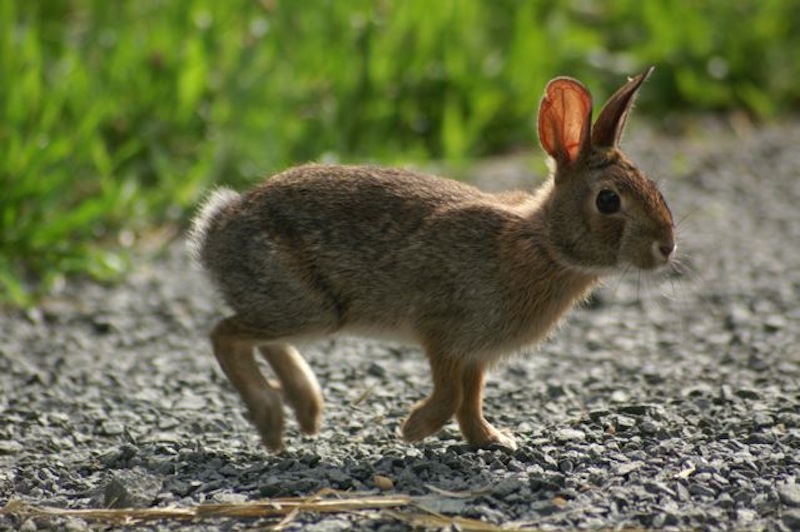CONCORD, N.H. — In an effort to restore the population of a species of rabbit endangered within the state, the New Hampshire Fish and Game Department is working to change the landscape of the state’s forests to create 1,700 additional acres of habitat for New England cottontails over the next 18 years.
Once common throughout the Northeast, the New England cottontail population has decreased dramatically over the past half century as human development of land and natural forest growth have cut into its available habitat.
But projects are under way to restore 2,000 acres of habitat across the state for the native rabbit by the year 2030, said Fish and Game biologist Heidi Holman. Since work began in 2009, the program has created 300 new acres of New England cottontail habitat.
Holman said the cottontail’s ideal habitat is dense patches of shrubs and brush, which provide the rabbits with shelter from predators and weather.
“We need stems that are so thick that you can’t walk through it,” she said.
The young forests where New England cottontails thrive are formed naturally when hurricanes, fires or ice damage knock down trees, giving vegetation a chance to regrow. Because humans usually intervene in events like wildfires or floods to prevent destruction, Fish and Game’s habitat management efforts include timber harvesting in late-stage forests, allowing the undergrowth to regenerate.
The Wildlife Management Institute estimates that the available habitat for the New England cottontail, which once spread from southeastern New York to southern Maine, has shrunk 86 percent since the 1960s. The population is now concentrated in five separate areas, including southern New Hampshire and along the New Hampshire and Maine coasts. The other current habitats are in southeastern Massachusetts and along Connecticut’s borders with New York and Rhode Island. All six states are working to create additional habitat, but only New Hampshire and Maine feature the rabbit on their state lists of endangered species.
State biologists look for tracks and other evidence of the rabbits’ presence in the snow to monitor the population, and the mild conditions of this past winter made it difficult for the scientists to confirm where the New England cottontails live and exactly how many there are.
In addition to cutting down trees, Holman said, the department is also planting shrubs like bayberry, Virginia rose and dogwood on old fields, to mimic the young forest growth that happens on long-abandoned farming fields.
“What we’ve done has worked,” Holman said. “There’s a big regional effort going on for the species.”
While the initiative has successfully created new habitats for the rabbits, Holman said it’s still too soon to tell whether it will ultimately result in an uptick in the New England cottontail population.
“In most cases, it takes anywhere from three to five, or even upwards of 10 years,” she said. “We’re not sure in all instances that the habitat will come back to the quality that it needs to. We don’t necessarily have any observed colonization at the time.”
In the Granite State, New England cottontails are primarily found in the Seacoast region, where wetter soil encourages persistent shrub growth. Holman said that the rabbits’ presence has been confirmed in very few locations in the state, including sites in Dover and Durham, as well as in young forests in Hillsborough County.
The creation of young forests benefits other animals as well, Holman said. Whitetail deer, the New Hampshire state animal, also need this kind of terrain, as do many species of birds, reptiles and invertebrates.
“It’s a type of habitat that’s really lacking in the landscape, so by creating more we’re sort of filling this need,” said Holman. “There’s a lot of forests, a few fields, but we’re diversifying the landscape. When you diversify the types of areas that wildlife can live in, you diversify the wildlife.”
Send questions/comments to the editors.



Success. Please wait for the page to reload. If the page does not reload within 5 seconds, please refresh the page.
Enter your email and password to access comments.
Hi, to comment on stories you must . This profile is in addition to your subscription and website login.
Already have a commenting profile? .
Invalid username/password.
Please check your email to confirm and complete your registration.
Only subscribers are eligible to post comments. Please subscribe or login first for digital access. Here’s why.
Use the form below to reset your password. When you've submitted your account email, we will send an email with a reset code.